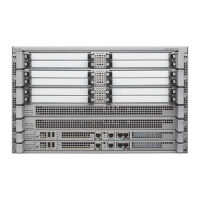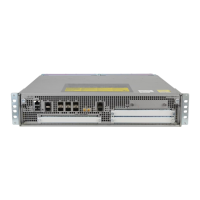20-18
Cisco ASR 1000 Series Aggregation Services Routers SIP and SPA Software Configuration Guide
OL-14127-08
Chapter 20 Troubleshooting the Serial SPAs
Using loopback Commands
Using loopback Commands
Loopback support is useful for testing the interface without connectivity to the network, or for
diagnosing equipment malfunctions between the interface and a device. The 2-Port and 4-Port Clear
Channel T3/E3 SPA supports both an internal and an external loopback mode. The external loopback
mode requires the use of a loopback cable and implements a loopback through the transceiver on the
SPA.
You can also configure an internal loopback without the use of a loopback cable that implements a
loopback at the PHY device internally. By default, loopback is disabled.
To configure loopback, use the following commands:
Verifying Loopback Mode
The following example shows that local loopback is set:
Router# show interfaces serial 2/0/0
Serial2/0/0 is up, line protocol is up (looped)
Hardware is SPA-4T3E3
MTU 4470 bytes, BW 44210 Kbit, DLY 200 usec,
reliability 255/255, txload 225/255, rxload 221/255
Encapsulation FRAME-RELAY, crc 16, loopback set (local)
Keepalive set (10 sec)
LMI enq sent 13281, LMI stat recvd 13280, LMI upd recvd 0, DTE LMI up
LMI enq recvd 1, LMI stat sent 0, LMI upd sent 0
Command Purpose
Router# configure terminal Enters global configuration mode.
T3/E3
Router(config)# interface serial slot/subslot/port
T1/E1
Router(config)# controller slot/subslot/port
Selects the interface to configure and enters
interface configuration mode.
• slot/subslot/port—Specifies the location of
the T3/E3 interface.
• slot/subslot/port—Specifies the location of
the T1/E1 controller.
T3/E3
Router(config-if)# loopback {local | dte | network
{line | payload} | remote}
T1/E1
Router(config-controller)# loopback {local [line |
payload] | diag}
Specifies the loopback mode.
• local—Loops back after going through the
framer toward the terminal.
• dte—Loops back after the LIU towards the
terminal.
• network—Loops back towards the network.
• remote—Sends FEAC to set remote in
loopback.
• line—Loops back toward network before
going through framer.
• payload—Loops back toward network after
going through framer.
• diag—Loops back after going through the
HDLC controller towards the terminal.

